OpenTTD implements path signals using the YAPP algorithm. During development, several ideas from TTDPatch, like marking the reserved path, were reused. On the other hand, many of the old signal features were simply thrown away because they were not suitable for the new concept. In the end, the new system is a very simple one, yet at the same time it is extremely powerful and quite realistic.
In principle, the old pre signals can be used together with path signals, but except for some rare special cases there is absolutely no need to do that.
Behaviour

Both path signals can be built using the GUI. They are available as semaphores (upper row) and light signals (below), the look of course does not affect the behaviour. The important distinction is between the signal to the left, which is the standard path signal, and the one to the right (with the red bar), which is the one-way path signal.
Path signals always show "Stop!", until a train has reserved a train past it into the block behind. As soon as the path is reserved, the signal switches to "Go!".
Path signals can only be built in one direction per tile. The old two-way signals with two signals on both sides of the track which can be passed either way, are not available as path signals.
This behaviour might seem awkward at first, but it is realistic and allows some very elegant solutions which would be impossible otherwise.
Examples
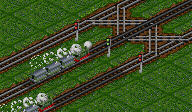
There are standard path signals in front of this junction. The train on the track in the middle has reserved a path, the corresponding signal shows "Go!". On the right hand track, another train approaches a signal. It has not yet reserved a path, hence the signal still shows "Stop!". Once the train has reserved a path, the signal will switch to "Go!".
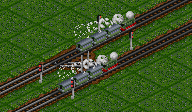
Here we have standard path signals on both sides of the signal block, always facing the junction. The destination of the trains is somewhere to the right behind the junction. As can be seen, trains ignore the signals when approaching them from the wrong direction, reserving paths across these signals. Keep this in mind when placing path signals!
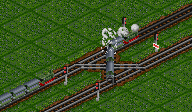
Now, the signal to the right is a one-way path signal (red bar). It cannot be passed from the wrong side. So, the train has reserved a path on the other track, the second train has to wait until it can reserve its path.
Safe waiting position
The position directly in front of a path signal is defined as being a safe waiting position. Paths through a signal block are only reserved towards the next path signal and therefore to the next safe waiting position. This theoretical definition can be directly translated into practical usage: A safe waiting position is given, wherever a train may stop without blocking switches, crossings and the like.
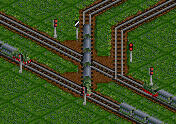
How not to do it: At this switch, signals were placed as it is common for the old signals, before and after the switch. This works in principle, but trains will soon block the whole crossing area, because they are waiting at a signal which should not have been placed there. In the picture one can see the train blocking the line to the left, which should not happen.
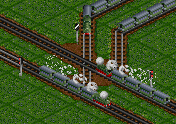
The correct way: The signals behind the crossing area have been removed. Trains which have to wait somewhere behind that area will have enough room to do so without blocking the crossing area.
